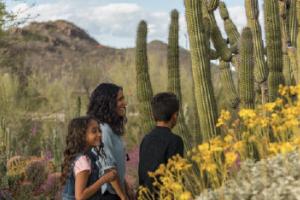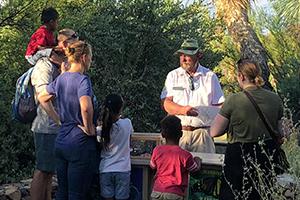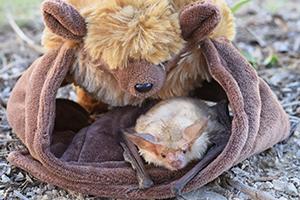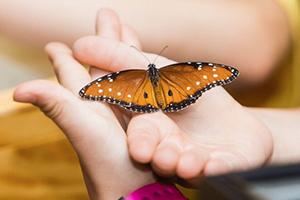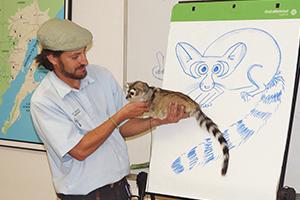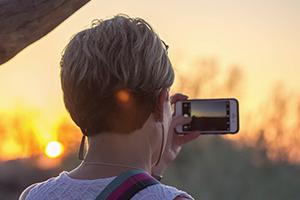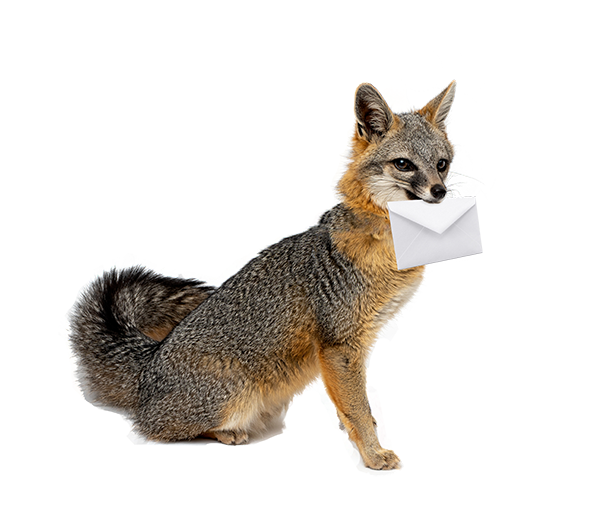
Bill & Beth Woodin Memorial Celebration
The Arizona-Sonora Desert Museum (ASDM) lost two special friends with the passing of Bill and Beth Woodin in the Winter, 2018. Bill was a herpetologist, a natural born educator and a talented administrator, starting as an ASDM volunteer in 1952 before going on to serve seventeen years as Executive Director. Beth was an ardent conservationist, a fierce defender of the natural history of the Sonoran Desert, and a long time member of the ASDM Board of Trustees.
The following are excerpts from the Bill and Beth Woodin Memorial Celebration held on Sunday, May 27, 2018 at the ASDM.
Craig Ivanyi
Good afternoon & thank you for joining us today. And, I thank the entire Woodin family for allowing us to host this tribute to Bill and Beth Woodin.
I am Craig Ivanyi and, as the current Executive Director of the Desert Museum, I have the honor of providing opening remarks. I do so on behalf of the entire Museum family, composed of almost 700 people who work and volunteer here, including the Museum’s Board of Trustees and Advisors. And, I do so on behalf of those who aren’t with us anymore, or couldn’t make it to the service. And I speak for those who care deeply, but have a difficult time making presentations at times such as this.
I’ve noticed that as I grow older it seems that I attend more events like this — celebrations of past lives, rather than welcoming new ones -- marking the end of relationships, rather than their beginnings. So, being at a memorial service isn’t a surprise. But, being at one for two people at the same time, let alone two people like Beth and Bill Woodin? That’s very different. I knew the day would come when we would be speaking of them in the past tense. But, I don’t know if there’s any way to truly prepare for when legends leave us — founders whom you’ve heard and read about, names you’ve seen in publications of the Museum’s history and on commemorative plaques. But, Bill and Beth are much more than the past, because they not only helped establish the Museum and guide it toward becoming the leader in natural history that it is today, they remained engaged with the organization up until the day they left us.
Beth Woodin was an ardent conservationist who served as a Commissioner for the Arizona Game and Fish Department and she was a huge force behind the reintroduction of the Mexican wolf in the U.S. Through thought and action, she was a mentor to so many of us. Beth was a rock star in Sonoran Desert conservation.
From what she told us, one day she came out to the Desert Museum in search of a job — little did she know that she wasn’t going to find this; instead, she found her future husband and perhaps, an unexpected way of life — the Desert Museum way.
Beth served on the Museum’s Board of Trustees several times for a total of 18 years (1981-1985, 1999-2005, and 2008-2014). She was still on the Museum’s Science Advisory and Animal Welfare Councils. Despite her long difficult battle with cancer, she was attending meetings up until the month that she died. Beth was a rock.
Bill Woodin served as Executive Director of ASDM for 17 years, and was part of the Museum from its beginnings. He not only helped launch and establish the Museum, along with a handful of others, he stewarded and helped it grow in size and stature. Essentially, he helped put it on the map.
He was an exceptional administrator — low-key and extremely supportive of the staff. He was polite and controlled and he appreciated their ideas and allowed them to be creative, which led to innovation, and contributed greatly to the Museum’s reputation.
Bill had a scientific mind and approach, with interests in eclipses, meteorites, and outer space. He was a voracious reader with an incredible passion for reptiles that the Museum greatly benefitted from.
On occasion that came at personal cost, like when a Gila Monster bit Bill through a cloth bag. Apparently, he calmly sat down, immersed his hand in ice water, and with a pad, pencil and watch, and took notes on his condition over time. We know he was precise in his writing, particularly in writing labels and correspondence. Correct usage of words and punctuation were very important to him, so we can only imagine how he approached this particular writing exercise. One note: though we know soaking in ice/ice water is not a good idea now, in those days it was one of the prescribed treatments. Fortunately, the bite proved to be not very serious.
Bill was always willing to do whatever needed to be done—routinely picking up wildlife donations at designated service stations on the way to the Museum, or making weekly stops at the slaughterhouse to pick up jars of blood to feed the vampire bats. He and his family raised many orphans, making bobcats, coyotes, and a wolf or two members of their family.
Bill was a charter member of the American Association of Zoological Parks and Aquariums, which became the Association of Zoos and Aquariums, the leading national organization that accredits the Desert Museum, today.
From what I understand, Bill worked very well with the Museum’s Board of Trustees, though I’ll never forget the day he told me over lunch, “The best Board is one that understands its job is to come in, sit down, and shut up!” As he said this I found myself looking at Beth, who was seated next to him, wondering how that struck someone who was so strong of spirit and opinion, who had served on the Board multiple times. So, I asked her that. She merely smiled and gave Bill a sidelong glance…
I never had the privilege of meeting Bill Carr or Arthur Pack. But I not only got to meet the Woodins, I had the opportunity to work with Beth, see presentations by Bill, have lengthy conversations with them, which allowed me to learn from them both. What an incredible gift.
From the first day each of them engaged with the Museum until the time of their deaths, they remained strong and active supporters of the Desert Museum, mentoring so many of us, especially those in living collections, and administrators like Bob Edison and me, helping us maintain our focus and commitment to its original purpose. These are things for which we are extremely grateful.
Arch Brown
We are gathered here today to celebrate the lives of two smart, dedicated, wonderful people — each has left lasting legacies. Bill’s sons are Peter, Hugh, John and Michael. Beth was the step-mom but she loved and respected all four as her own. Our condolences to you four and the rest of your families. Bill graduated college with bachelor’s and master’s degrees in zoology, but he was a herpetologist and specifically a snake guy at heart. In fact he named the snakes that were wild on their property and talked to them as one does with any pet. If a car was coming up the drive, he would say ‘a car is coming, get into your hole’ and the snake would. That’s control.
Bill was a guy who was organized and set in his ways — before dinner he always had a vodka tonic. At dinner, he would always have a glass of white wine. His duties as Executive Director of the Desert Museum started in 1954 when he was one of five staff. His first self-imposed duty each morning was to clean the ladies’ restroom. It’s true. Under his management of seventeen years, the Museum flourished in every way. He positioned it to a place where it’s become the success it is today. Bill’s second passion was U.S. military small arms ammunition. He leaves an enormous collection of cartridges and co-authored an amazing three-volume history that was revised in 1998. I used to see him at the annual shot show where he was a sought-after expert.
Beth was a passionate land conservationist and animal protector. She was the force behind the creation of Arizona Heritage Alliance Fund, 28 years ago. It allocated $20 million dollars per year from casino gaming funds and realized the protection of almost 18,000 acres of habitat — quite an accomplishment. One of Beth’s recent projects was to get those funds re-instated.
Hopefully, this work will continue. She will love those efforts. Beth was often rescuing abandoned or abused dogs. She was easily sold on the fact that they were pure-bred of one or another. Bob Edison tells me that she had often been duped but her love of the animal far outweighed any pedigree. As we all remember, one of her greatest personal traits was to make the best out of everything. We’ll all miss them tremendously — both of them - like you I am honored to have known them. Thank you.
Gayle Hartmann
I’m going to speak about Beth. A number of years ago, I worked at the University of Arizona at what was then the School of Renewable Natural Resources on a big natural and cultural resources management plan for what is called the Barry M. Goldwater Range. The Goldwater Range is about 2 million acres of splendid Sonoran Desert in southwestern Arizona. My boss — our boss at the time was Dr. Stan Brickler, a professor there who was very much a conservationist. In talking about the job that we had to do, he would say repeatedly that we had to act as ‘lawyers for the trees’. He would add that the trees — and of course all the plants and critters of the Sonoran Desert and Sky Island Mountains can’t speak out on their own behalf. They can’t defend themselves and so it is our job to speak for them. And that of course is exactly what Beth Woodin did. She spoke and acted on behalf of the natural world that surrounds us. The world that was here, long before any of us arrived on the scene — and the world that is essential to our survival. Beth Woodin was a ‘lawyer for the trees’ and an extremely good one.
What exactly does being a ‘lawyer for the trees’ mean? It doesn’t mean you scream and holler and Beth never did any of that. It does mean that you work in an organized way, an educated way, a passionate way. You reach out to many people, all kinds of people, and you don’t give up. And that’s the way Beth worked. In the 1980s, she persuaded the Arizona Legislature to create a Wildlife Check-off Fund — she and others — which provided funds to protect non-game animals. In 1990, as you all know she was appointed by Governor Rose Mofford to be on the Arizona Game and Fish Commission. And in my opinion, Beth was the best Game and Fish Commissioner that Arizona Game and Fish Commission ever had. A little more recently, she was instrumental as Arch Brown said in creating the Arizona State Parks Heritage Fund to purchase and protect land. She fought doggedly to keep that fund in place when the state legislature tried to take the funding away, which of course they ultimately did. And right now, if she were here, I know she’d be fighting to get the funds back.
Now the issues that I just mentioned were big state-wide issues, Beth also tackled little local issues, such as the one I’m going to recount. One day, years ago, she called me with concern in her voice, and she said that she had learned that Pima County was going to ‘improve’ Gates Pass Road. We both knew that when the word ‘improve’ is used relating to an activity in the natural world the result is frequently not an improvement. So we envisioned a major widening job that would change Gates Pass Road from a narrow twisty road, winding its way through steep rocky saguaro slopes into a wide flat road with big shoulders that would separate the people in the cars from the beautiful desert they came to visit. So, since the both of us had the tendency to voice our concerns, we took action. I can’t quite remember the chain of events, but I think Beth probably called the relevant member of the Pima County Board of Supervisors and expressed our concern. The supervisor then put us in touch with a gentlemen who I think was head of the Department of Transportation at the time or at least he was the engineer for this project — he’s long gone. We didn’t know him — and he didn’t know us — but I imagine he had checked up on us before we all met. It was obvious that he knew we were not to be taken lightly and he was clearly nervous. We voiced our concerns and he listened and then he patiently and repeatedly explained that there was to be minimal widening. The sole purpose was to remove small quantities of rock in a few places where the steep-sided cliff face jutted out practically onto the road. And I assume a number of cars had had minor contact with the cliff face and thus the County felt the need for action.
So after quite a lot of discussion, we parted more or less amicably from the County guy. And Beth was still concerned and so was I. Having both been defending the environment for many years, one thing we knew was that you could never be sure an issue was going to turn out well until it has finally and completely happened. For a few days, I think we both had nightmares about the future of Gates Pass Road. Then we went to take a look. And we could hardly see the difference. The County had done its job beautifully. The road was no doubt safer, but it was still the narrow twisty road that we loved.
Thus, as you can see, Beth was also a watchdog on the small issues. As it turned out in the Gates Pass Road case, a watchdog may not have been needed. On the other hand, maybe she and I encouraged the County to act more cautiously than they would have otherwise. So I would suggest that we all follow in Beth’s footsteps and work to protect the natural world in which we live, by working on both big issues and little local issues. In other words, we all need to become ‘lawyers for the trees’. Thank you.
Mel Carpenter - for a different side of Bill Woodin
Good afternoon. It’s been a while since I’ve been up in front of a group of students. I’m a retired professor of aviation at Florida State College in Jacksonville. I live in Jacksonville, Florida. I’m a retired Navy pilot and have been a cartridge collector for many, many years. I’m very, very happy to be able to be here today and share some memories of Bill in an activity that some of you may not know much about.
How many of you know what cartridge collecting is? What am I talking about? Not everybody is raising their hand. I’m going to tell you about that but first I want to share with you a memory that I have engraved in my brain of Bill Woodin at the Arizona-Sonora Desert Museum. On one of my cartridge visits to the lab, he asked where I might like to go in Tucson — and was amazed when I said I’d love to see the Museum. Apparently, that doesn’t happen all the time. So he brought me out here and he and I approached the ticket window and he went up to the window and the young lady said that will be $25 and I said ‘well something interesting is going to happen now’. And Bill said ‘Well, I’m a member’. ‘Oh, ok, Do you know anything about the Museum? Is this your first visit to the Museum?’ And Bill was so humble — he was this way all the time I knew him — he said ‘I do know a little bit about it.’ And she said — ‘well if you need any help we have docents — we have people that will guide you along’. And he said ‘thank you very much’. He was as appreciative as he could be for the help that she was offering him.
But today I’m not really here to talk about the Museum, I’m here to talk about the hobby of cartridge collecting. And cartridge collecting is identical to stamp collecting or coin collecting — except for the differences. Cartridge collectors are generally historians that love to do research, love to find new items to figure out what it is. Get together at annual cartridge meetings and quarrel over the details of the history that’s involved with a round of ammunition. We think it’s a sacrilege to shoot ammunition. That destroys a valuable collector piece. We are very interested the variations — however slight — between one round of ammunition and another. Bill got started in cartridge collecting at a very young age and wound up in the Second World War in the American Field Service in India — and I believe Burma -- as an ambulance driver. He was given the option — he told me - of going to Europe to be in the war effort or to go to India and guess why he chose India? Because of the snakes. He had a pet cobra that he kept in his tent and a couple of other snakes — I’m tempted to say pythons, but I’m not a herpetologist so I better be careful — and while he was there, of course, had all the opportunities in the world to collect ammunition. Well guess what kind of ammunition you have in the middle of a war — military ammunition. And that’s what guided him towards his specialty because most cartridge collectors have a specialty. Mine is the same as his. You get into military cartridge collecting and police.
I should say that one of his strongest suits was his ability to share his information — to answer questions. When he came back from the Second World War and went to work here as the Director in 1954, I was amazed — flabbergasted -- to learn that in 1955, one year after assuming the directorship here — guess what he did? — he started the International Ammunition Association as its vice-president. He was a co-founder. He didn’t have enough to do here at the Museum so in his spare time he started the world premier cartridge collecting association. He was also very active in European Cartridge Research Association. He wrote countless articles. I can’t imagine how many articles he wrote in our journal — and he co-authored three books. Before volume three of the History of Modern U.S. Military Small Arms Ammunition came out, I was writing my own book on gyro jet ammunition — gyro jet is a little miniature rocket — kind of specialized round of ammunition. And I asked Bill to proof read my work. He was very, very supportive of anybody who would do research in an area that he didn’t have time to do. You know he invited me out to Tucson to pour over his gyro jets which were the best in the world, of course — as everything else was over there. And when I asked him to proof the chapters. I would send him the chapters and I had no idea that he had that much red ink. Bill worked with me and taught me and educated me. I thought I was pretty smart but apparently not so. He had a reputation as ‘’the king of commas’ . He was ‘the king of semi-colons ‘. And if I had a hyphen that was out of place or a comma that wasn’t necessary or was missing, there was a ‘red’ mark. But as a result about 500 pages of my book - which was later published — was a much better product. And I think because he had spent so much time training me when it came time for Volume 3 of The History of Modern U.S. Military Small Arms Ammunition, he asked me to edit it — which was a great honor and to publish it — which I did. There’s a copy of it on the table in the lobby. Take some time and thumb through it and you can see what a tremendous amount of work that Bill put in to spread the word to let other people know about cartridge collecting and the specifics of the type of ammunition that he collected.
He was always, always very careful to encourage youngsters to get involved with the hobby. He was never too busy to answer a question. He was the ‘grand guru’ when he would be at one of our cartridge collecting meetings — either in Chicago and then later in St. Louis or in Europe, in Switzerland, Czechoslovakia, Germany. He and Beth travelled to every one of them and had a ball — with the cartridges and the wine and the food. And for Beth collecting clothespins too so she had a little bit of a collection. But Bill was always available and willing to sit down a new collector and explain why this was a great cartridge and they ought to get this or that’s not-so-good - it might be fake. Bill has probably the world’s largest fake collection. No, I’m serious. It was very important to Bill to gather all the fakes he could. Most cartridge collectors when we found out we had a fake we’d throw it away. We get a big hammer and turn it into a metal pancake. But Bill said ‘no — send me all the fakes’ and that way he had a live database of the actual cartridges laid out so if somebody had a questionable cartridge, he could compare it with his — and help possibly identify it. The center of the world — as I close here, before I ‘get the hook’ — for cartridge collecting is right here in Tucson, Arizona in the Woodin Laboratory. I was very thankful and very honored when Bill asked me to serve on the Woodin Laboratory Foundation which emphasizes research, and education and identification. During the Warren Commission, after the JFK assassination, Bill Woodin identified the cartridge that was used in the assassination. People, world-wide agencies — federal, state, local — would come to the lab and request his help because he was the subject matter expert on military and police ammunition. That apparently is going to continue. Just this week, when I was over working at the lab. I looked at 160,000 cartridges — and that was before I went into the duplicates room.
It looks like the collection will be hopefully kept intact rather than dispersed in little pieces. We don’t know that now — things are in motion —hopefully that’s the direction that the brothers are taking which I’m very, very happy about. If you have any questions about cartridge collecting feel free to ask me or any of the others. Thank you.
Eric Woodin
Hello, I’m Eric — Bill and Beth’s grandson. When I think of Granddad and Beth, I think of how well they took care of me. Whether it was planning a treasure hunt for me when I was a kid, employing me at the famous lab, or making sure that I dined with them at the finest restaurants all over Tucson. I remember as a young kid being fascinated by treasure and wanting to find my own buried treasure. I remember Beth saying to me ‘well you know what Eric, you are in luck. Legend has it, that there is treasure buried at Cloud Road and I have a map of the treasure’. And just like that Beth handed me a map that looked to be over 100 years old, with burnt edges and a big ‘X’ on it. I remember just grinning from ear-to-ear. Got so excited to embark on my own adventure to find the long lost buried treasure. And before I knew it, we were off with me leading the way. We wandered the creek near Cloud Road and then I saw it — a giant Sycamore tree. As I looked down at the map, I noticed that ‘X’ marked the spot near the Sycamore tree. I raced over to the tree and began to dig as fast as I could. And before I knew it, I had found the treasure. It was such a wonderful feeling —and one of my fondest memories as a child.
As I grew older, Granddad and Beth indulged me in my next fascination: food. The summer I spent working at the Lab I remember cataloging cartridges, ten o’clock coffee break — and of course eating two sandwiches for lunch. You see as a hungry teenager I hinted to Beth ‘do you know what’s was better than one sandwich? Two sandwiches! And you know it’s the darndest thing — I couldn’t tell you about cartridges — well, maybe a little more now - but the turkey and avocado sandwiches were great. In fact, I attribute the two sandwiches a day to my height.
As you can tell, food is very important to me. So, I’m very grateful for a tradition that started the summer after I worked at the Lab. Every year for my birthday, Granddad and Beth would take me out to one of the nicest restaurants in Tucson. When we first began our tradition, I didn’t know the difference between a salad fork or a dinner fork — or that the entrée is the main course of your meal. When we dined at the Tack Room, Beth saved me from ordering a salad as my entrée and Granddad educated me on the use of a finger bowl. He said ‘whatever you do, don’t drink it.’ Not only did they help me with my manners, they also made sure that I dressed appropriately. Beth bought me my first blazer and also made sure that I didn’t wear my nicest tie to a meal at Pinnacle Peak. For those of you who don’t know, if you wear a tie to this restaurant, they will promptly cut it off. During the meals that we shared, I’m thankful for all the stories that they told me and the family history that they passed on to me. I will miss Granddad and Beth dearly. I’m grateful for all the love they gave me and the time that we spent together. As I reflect back to the time when I found the buried treasure at Cloud Road, I now realize that the true ‘treasure’ was having Granddad and Beth in my life. Thank you.
John Woodin
Growing up with a herpetologist father, there are lots of lessons to learn. Keep to the facts. Never exaggerate. And above all, never, ever, ever say a snake is longer than it is. I remember more than once having to pull out a tape measure to prove that I had not overstated a snake’s length.
My favorite snake lesson is this. I was maybe ten and we were driving back from a camping trip in the Pinacates when we came upon a Diamondback rattlesnake. As with every snake we ever saw, we stopped to admire it and then get it off the road so it would not be run over. This snake, not appreciating our good intentions, got rather agitated — raising up, rattling away, putting on quite a show. My brothers and I were duly impressed but were prudent to stand back. Dad seeing our hesitation launched into a talk on ‘how close you can really get’. ‘We can walk faster than a rattlensnake can crawl’ he said ‘and besides they can’t strike much more than a third of their length. If fact, you can stand right next to them’ -- which he proceeded to do. This did not however improve the snake’s disposition — and we did not budge from our spot. Dad thought a little demonstration was in order. He stuck out his foot to what he thought was a safe distance. The snake struck and hit the bottom of his shoe. Dad totally unfazed but a little embarrassed said ‘well maybe they can strike a little further than I thought — there are always exceptions’. As we were walking back to the truck, he added ‘no need to tell your mother.’
Snakes were how Dad and Beth met. They were at a party and Beth went up to Dad and asked his thoughts on a Trans-Pecos Rat snake she had. I don’t think that will ever be a top ten pickup line, but it sure worked on my father.
I was out of the house by the time they met, so Beth and I didn’t really have the closeness you get growing up together. All that changed over the last 2½ years that Beth had cancer. During that time, I went to all her doctors’ appointments. Drove her to chemo or radiation, when she was too sick to drive — do whatever needed to be done. I spent more time with Beth than in the previous forty years. And for that I’m forever grateful. She called me her ‘advocate’ which I always really liked hearing. I had more than a few talks with Beth about slowing down — ‘put yourself first, just a little bit’. Every time she would look at me and smile — that smile we all know - and say — ‘not a chance — that’s not who I am or how I live’. If the choice was between a political or environmental event — of which there were many — or a medical appointment which were endless, she would always pick the former. Beth was willing to put up with being sick, but she absolutely refused to let it dictate how she was going to live. I’d like to tell a few funny stories, but really cancer doesn’t have a lot of fun. Although there was a fair amount of cancer humor between us which tended to be rather dark — and doesn’t really translate very well.
The day before Beth died, I asked her if she would give me something she treasured. She thought for a while and then pointed to a basket with the pattern of a Diamondback rattlesnake on it — and said it was one of her most treasured things and she wanted me to have it. I put it on the wall facing the chair I usually sit in — so every day I can look up and be reminded of Beth — full of inspiration, dignity and an incredible, indomitable spirit of life — what an honor.
Peter Woodin
Good afternoon, I’m Peter Woodin and I’m the oldest of the four Woodin boys. I want to thank first of all Craig and everyone here at the Museum for the generous use of this facility today and hosting the memorial service for our father and Beth. I think it’s a completely fitting place for us to gather and remember them. And so thank you very much, Craig. And thanks to those who helped — I live in New York, so I haven’t had that much of a role in putting the day together. My brothers John, Michael and Hugh carried the bulk of the effort with some of the other folks associated with the Museum -- and family friends. In particular, I want to thank Peggy Larson, who has done a yeoman’s job in helping us get everything together.
In a moment I’m going to say a few words about my father before I get to that, I have a remembrance of my father from my brother, Hugh. Hugh says the following — and before I read what he said — it would probably be helpful for those of you who don’t know that Hugh is his middle name. His first name is actually William. So he goes by W. Hugh Woodin. ‘When I was around seven or eight, Dad and I were outside when Beowolf, the family wolf who was acquired and raised from a cub courtesy of the Museum, came bounding up to see what we were up to. Dad scratching Beowolf’s back and stomach said ‘ what a good wolf - Wolfus H. Wolfus’ and then he looked over at me and smiled and said ‘WHW great initials!’’ I smiled back feeling rather special’. Another remembrance that Hugh has asked me to convey and this is about Beth. Much has been said about Beth with regard to her dedication to all things nature. She was also extraordinarily dedicated to family. The memorial for my mother — our mother had died a year ago. The memorial for my mother was on Memorial Sunday last year and held up in Oracle on the back side of the Catalina Mountains where she lived. My father could not go, but Beth attended. That day was Beth and my father’s 40th wedding anniversary. That was Beth.
So let me turn to what I have to say and you’ve already heard from Craig and Arch and Gayle and Mel. Thank you all very much for your remembrances and your thoughts. As I think is true for most children, our father loomed large in our lives. Of course, he knew a tremendous amount about the desert and particularly about snakes. You heard today about his tenure as Director of the Museum and his work as a collector, consultant and researcher in the field of military ammunition. But he had many other skills and talents and passions which many of you may not aware of — and which might surprise some of you. He loved word play - palindromes and other quirks and oddities of the English language. For instance, one day he asked us what was so unusual about the sentence ‘It is up to me if it is to be.’ Well, we kind of looked at him and said: ‘Can you give us a hint?’ The answer according to him, it is the longest sentence in the English language made up entirely of two letter words. That was our father. One more: a lengthy paragraph he once showed us beginning with the observation — the first sentence in the paragraph was — ‘This is a most unusual paragraph’ — but at the end of the paragraph as you read through it — it ended with a question — ‘do you now know what is so unusual about this paragraph?’ Well, we all read it carefully several times and we admitted defeat ‘We don’t know Dad. Please tell us.’ He said ‘Well, I found it immediately. The letter ‘e’ is the most commonly occurring letter in the English alphabet, but there is not a single letter ‘e’ in any word in that paragraph.’ I remember it vividly. Some years ago, he gave a talk on word play at the Tucson Literary Society which I’m told was very entertaining.
Here’s more aspects of him. He was a superb athlete — superb. His picture appeared in a national golf magazine when he was eight years old. And there are pictures we have of him carrying his clubs on the golf course with a little beret and little knickers. He was the pitching captain on his baseball team in high school. And over the course of his senior year, he averaged almost two strikeouts per inning over the entire season — a school record that stands today. He was also a skilled boomerang thrower and for those of you who went camping with us you’ll remember him taking them out on the beach and trying them out. He would go on at length about the various types and purposes of boomerangs , and how the different shapes affect the boomerangs path through the air and how precisely they return to the thrower.
One skill I remember especially was his skill with a bullwhip. I don’t know how he picked it up. I don’t know he practiced it. But I do remember one particular day when he claimed that he could strike with a whip a cigarette out of a man’s mouth — and he wouldn’t feel anything but the breeze of a whip. Well, not surprisingly, my brothers and I expressed some skepticism. So he offered to give us a demonstration. None of us were willing to volunteer as a guinea pig however. So with some impatience ‘What’s wrong? Are you afraid?’ He took a cigarette and laid it over the edge of the dining room table and put a book on top of it, so that it stuck out a couple of inches. And he walked back abut fifteen feet away with his coiled whip and he put it down on the ground and he kind of looked at it and got his thoughts together and then slowly he raised his arm back — and then ‘whoosh’ that whip went forward and snap that cigarette was cut in half. He was good with the whip.
We’ve heard this afternoon about how our father was a passionate lover of the natural world and in particular our southern Arizona desert. I think probably one of the things I am most grateful to him for is that he instilled in my brothers and me the same love of the desert which he was so passionate about. Of course, he had help from our mother, Ann Woodin, who — we’ve already heard — whose memorial service was a year ago today. While they were separated for almost separated for almost fifty years, throughout the years that we grew up, our parents created for us a home — a childhood — that allowed each of us to become the type of person that we are today. For that reason, we remain eternally grateful. I’m most grateful for instilling in us his great love of the desert. And I’ve since wondered: ‘How exactly did that happen?’ Of course, we grew up in the desert and in my memory, much of our childhood was spent outdoors exploring a particular corner of the desert in which we lived. It was a beautiful spot — the house they built in the early 50s close by Sabino Creek — and in those days — it was far outside of town. That’s not so true any more.
We spent many a long summer hot afternoon splashing and playing in the creek. But what shaped our love of the desert more than anything I think was not just the fact that we lived in the middle of it but how much we learned about it from our father. We heard the word ‘educator’ — that was his passion. That continued when Beth came into his life for she brought to their marriage that same passion, deep knowledge and wide ranging curiosity. My brothers and I were very glad to see them together.
It was our family walks I think that I best remember. Most afternoons, when our father returned home from the Museum, he’d walk into the kitchen and put down his lunch pail and then turn around and step back outside. My mother and my brothers and I would follow along behind — usually with a few dogs — and we’d head out into the desert for our afternoon walk. We headed north for a ways over a low ridge, and then dropped down into a dry wash. And then we’d head down the wash towards the creek. And at the creek, we would check out whether it was still running from bank to bank or whether it had started to recede and the pools would be forming with the small fish. We’d walk down till we got to the path that led back to the house and head back to the house. Although it was usually the same route, it seemed that almost every walk something captured our attention. Maybe it was a snake skin - a shed skin tangled up in a bush, maybe it was a velvet ant crossing the path or red-tailed hawk drifting overhead looking for its next meal, or raccoon tracks in the damp sand down by the creek. It seemed that for everything we saw, our father had a story about how the plant or animal lived, what it ate, and what ate it — and what role it played in the life of the desert.
And as I reflect back on our father’s stories, I realized how much we learned on those walks. Our love of the desert grew as the desert became familiar to us and as we began to see it for the rich and complex and wonderful world it is — a world in which we came to feel so completely at home. As I wrote these remarks yesterday, I realized that what my father did for us on those walks, how he encouraged our love for the desert by teaching us about it was pretty much exactly what the Museum does for the countless people who pass every year through the front entrance on the hill behind us. The Museum educates them, helps them understand the desert, and helps make the desert familiar to them. And in this way the Museum gives its visitors that same opportunity to grow their love for the desert as our father gave us on those walks. That I think is the fundamental vision of the Desert Museum and a vision which our father had the great privilege and great joy to help nurture through the years of his tenure here. Thank you.
Craig Ivanyi — Closing Remarks
The loss of Bill and Beth is felt by all of us close to the Museum, but it cannot compare with the sense of loss the Woodin family is dealing with right now, especially after losing Ann only a year ago. On behalf of all of us who have had the honor of representing the Museum, we extend our condolences to all of you and our deepest thanks for allowing them to be who they were and do what they did to create and steward this pioneering and world-renowned organization.
Woodin Memorial Fund Announcement — 5/27/2018
Bill and Beth Woodin were pillars of this community, part of the foundation of the Desert Museum, and in their honor, the Museum is announcing the establishment of the Woodin Memorial Fund to honor Bill and Beth Woodin and their many contributions to conservation, environmental education and the Arizona-Sonora Desert Museum. The fund will support specific programs and projects consistent with the interests and causes relating to the Museum - the first of which will reflect Beth Woodin’s long time interest in and advocacy for the Mexican Grey Wolf and focus on the Museum’s immediate desire to upgrade its wolf exhibit. Other programs and projects will follow specifically to honor Bill to be determined by senior staff and the board of trustees as we move forward.
For further information on the Woodin Memorial Fund, contact Lynnae Wenker at 520-883-3005 or lwenker@gregorybgallagher.com.
